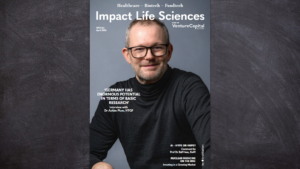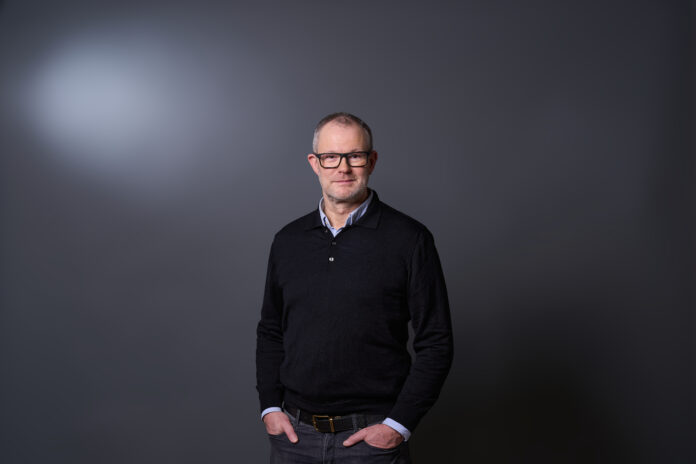Bildnachweis: HTGF, VentureCapital Magazin, HTGF.
Life sciences expert Dr Achim Plum has been on the management team of High-Tech Gründerfonds (HTGF) since January 2025, strengthening the life sciences sector at the highest level.
VC Magazin: What plans and goals have you set yourself for your new role?
Plum: The HTGF management team is a trio, with each member representing an investment sector and working both internally and externally. With 25 years of experience in the life sciences segment, I bring a strong industry background and perspective to my new role. I am in the very fortunate situation of having joined a very well-oiled machine. HTGF every year looks at literally thousands of pitches, makes a significant number of investments, and has built an impressive track record of success. With my external perspective and operative management experience, I have set myself the initial task of identifying areas that can be further improved with respect to operational excellence and efficiency. However, we are already operating at a very high level. Apart from operational aspects, I also want to review our life sciences and chemistry portfolio and, with the team, further develop focus areas that we believe are particularly relevant in the sector but also to German society. Last but not least, I want to further strengthen our reputation as ‘smart money’ for life sciences and chemistry.
VC Magazin: With you on board, HTGF is strengthening the life sciences sector in its management. Where do you see the local early-stage market in the life sciences sector?
Plum: In my view, it is important to massively push the life sciences sector in Germany, as the country has enormous potential in terms of basic research. We need to improve translation and get more horsepower on the road in order to fully leverage the economic and social benefits of the excellent research in this area. However, the early-stage market is challenging. Germany traditionally has a risk-averse investment climate, and economic downturns are felt quickly. Still, there is always money available for great ideas. In this respect, HTGF plays an important role as a seed-stage investor to get things going. Once important first milestones are achieved with such seed funding, we are quite good at helping the strong portfolio companies to obtain follow-on funding. Last year, for example, we recorded follow-up financing totalling EUR 1.4 billion in our portfolio, which is the absolute record to date – and EUR 800 million of which went to life sciences start-ups alone. Of course, you have to bear in mind that life sciences are generally very capital-intensive, but this nevertheless shows that there is capital available. With the launch of the HTGF Opportunity Fund last year, we can now participate significantly in growth rounds for start-ups within our portfolio – a very important addition to our toolbox. Our aim is to develop our portfolio companies into major players and ideally keep them in Germany.

VC Magazin: Do you see an increasing migration of life sciences companies to the USA or China, for example?
Plum: In the drug development sector, it is an absolute exception for a company to develop organically through all clinical phases, and this is also very difficult to finance. Here, M&A is the typical exit scenario, and this is an international business with buyers located in the US or elsewhere. Often, however, the value chain is not entirely relocated to existing sites of the acquirer, but the companies at least continue research operations in Germany. For start-ups with strong platform technologies for drug development, it would be desirable to see more licensing deals rather than acquisitions so that the companies can continue to grow in Germany. In diagnostics and medtech, the situation is similar in the sense that M&A is the major exit channel. However, here the costs of market development for innovative products are typically hard to fund in Europe, forcing the companies into an early exit.
VC Magazin: You can look back on 25 years of experience in the life sciences sector. What industry trends and developments are you currently aware of; which topics are particularly
exciting for investors this year?
Plum: We are currently seeing a lot of development in antibody-drug conjugates with target-specific antibodies – this is very attractive because it offers a good risk profile. Oncology continues to be a strong indication area, but the neurological field is also very exciting. There have been initial successes with disease-modifying therapies in Alzheimer’s, and it remains to be seen how this development will continue. Cardiology is also interesting; HTGF made an outstanding exit here last year. The Danish global healthcare company Novo Nordisk acquired our portfolio company Cardior Pharmaceuticals for up to EUR 1.025 billion – the second HTGF life sciences unicorn and another example of the potential of RNA-based drugs. Artificial intelligence is set to become a key driver of innovation in drug development as well as diagnostics as it leverages the enormous amounts of data we can today generate very cost-effectively with high-throughput technologies. Our portfolio company Aignostics is a good example in that space. The company attracted much interest by industry-leading collaboration partners as well as reputable venture capitalists. In the long term, gene therapy will play a major role, as gene editing opens up completely new opportunities. In combination with novel vector technologies that improve the targeted delivery of gene therapy to specific cell types, we expect to see exciting developments in that space. I also see great potential in synthetic biology, both in the medical and industrial biotech segment. In short: the life sciences are a very dynamic field!
VC Magazin: In your career to date, you have also accompanied two IPOs. However, the stock market has not been a real exit channel in recent years. What are your expectations regarding a stock market window for life sciences this year?
Plum: I am very cautious about an IPO window this year. On the one hand, the industry is
perceived as a high-risk sector; on the other hand, the geopolitical situation is very tense, and uncertainties have never been favourable for IPOs. Germans, in particular, are highly sensitive to this. An IPO at the EU level might be possible, but my expectations remain low. Unfortunately, it has to be said that we need these IPOs if we want to build large, new companies in the long term. I find it very alarming that the stock market is still not a viable exit strategy for life science companies in Germany. In 2024, there have been four IPOs in Germany and 57 in Europe, compared to about 230 in the US and 270 in India. In the long term, we need more large companies in Germany to distribute industrial growth across a broader base. Unlike M&A, the stock exchange is an excellent channel to achieve this.
VC Magazin: HTGF was recently able to realise two life sciences exits to strategists. How do you assess the current exit channels; which players do you perceive as particularly strong?
Plum: In general, we are seeing something that has long been common practice in the drug development sector: early development takes place in small companies, and innovative compounds are then insourced via M&A or licensing by large corporations. Hardly any start-up company can afford to take on the entire drug development alone. Regarding the players, I am very positive that partners and acquirers will always be found for innovative new drugs. However, as mentioned before, these players are often not located in Germany – pharma is a very international game. Medtech, on the other hand, is traditionally very strong in Germany. Here, it may be easier to find local partners or buyers and retain the value creation in Germany.

VC Magazin: You have been involved in several life sciences companies and bring an entrepreneurial perspective to your new position. What particular challenges do you think life sciences founders are currently facing?
Plum: Life sciences start-ups are typically very deep on the technological side. However, this also means that the founders often have a very scientific approach. In particular in areas like medtech, diagnostics and life science tools, we often see that they have an innovative technology and then look for a problem to solve with such technology. This is a recurring phenomenon in Germany, as we are very tech-rooted. But that’s likely not a good approach. You first require a strong unmet market need, a gap, and then use an appropriate technology to find a solution. But if my technology doesn’t make the solution significantly faster, better, or cheaper, it becomes difficult. In general, the demands on a pitch have also become significantly higher, which goes hand in hand with the scarcity of early-stage capital. Here, many founders are competing for the same, limited pot of money, and really understanding the market for the intended product and delivering a convincing business case and market access strategy becomes crucial. And certainly, building good complementary teams is key. Often, founders meet at university and all share similar scientific backgrounds, leaving open flanks on the operational and commercial side. I always encourage founders to have the ambition to be the most ‘stupid’ ones in their teams in the sense that they should have the courage to get people on board that excel in areas that they themselves have little experience in.
VC Magazin: Donald Trump’s presidency has caused a jolt in the economy. Do you expect the USA to have an impact on the German life sciences market this year?
Plum: That is not easy to foresee. We have anecdotal reports of portfolio companies that academic collaboration partners in the US suffer from grant cuts or that it is seemingly more difficult to get meetings with the US-FDA. However, currently we do not see any direct implications. Luckily so, as US venture capitalists significantly invest into our portfolio companies and the US is still one of our most important exit markets, be it through M&A or IPOs. While it is of utmost importance to strengthen the domestic economy and enable IPOs in Germany and the EU, we should continue to foster mutually beneficial partnerships with US venture capitalists and industry players.
VC Magazin: Thank you very much for the interview.
About the interview partner:
Dr. Achim Plum, Managing Director of HTGF, has 25 years of experience and a strong network in the life sciences industry. He holds a PhD in genetics and combines scientific expertise with extensive management knowledge. He has successfully led companies through growth phases, supported two IPOs, and is familiar with the financing perspectives of companies across all development stages.





